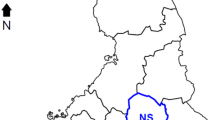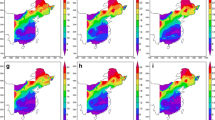Abstract
Changes in soil organic carbon (SOC) can lead to increased concentration of carbon dioxide (CO2) in the atmosphere and eventually contribute to climate change. Simulation models are useful tools to evaluate the effect of future scenarios of climate change on soil CO2 emission in the long term; this study aimed to: (1) evaluate the performance of RothC model using SOC data measured from five different vegetation covers in a semiarid region (southern Iran); (2) assess the impacts of present climate and climate change scenarios on cumulative CO2 emissions from soil; and (3) assess the net effect of climate change on soil CO2 emissions by comparing the two scenarios. The following vegetation covers were studied: rangeland, cypress trees, almond trees, cypress understory and almond understory. Model validation indicated that RothC accurately simulated SOC measured data (R2 = 0.97; Pearson correlation = 0.98; performance efficiency = 0.96). Results showed that climate change effect on soil cumulative CO2 emissions increased by 2050 under all vegetation covers, although not significantly in each vegetation cover in comparison with the present climate scenario. The extent of soil cumulative CO2 emissions may be related to the different decomposability of plant materials and soil carbon input (plant material quantity) in tree covers and rangeland/understory covers, respectively. However, vegetation covers with the highest and lowest soil cumulative CO2 emissions did not correspond with the highest and the lowest values of soil CO2 emissions under the net effect of climate change. In addition, trends of the soil CO2 emissions were decreasing in all vegetation covers during the 2014–2050 period. We argue that under the net effect of climate change SOC will be resistant against further decomposition over time. In fact, easily decomposable materials are fully or partially depleted, and microbial population and decomposition rate of litter materials will decline. This also implies a chemical change of organic matter and the formation of humus complex compounds showing a high resistance to decomposition. Therefore, the study of organo-mineral complex and humus complex compounds in the soils of this region is recommended for future researches.





Similar content being viewed by others

References
Albaladejo J, Qrtiz R, Garcia-Franco N, Navarro AR, Almagro M, Pintado JG, Martinez-Mena M (2013) Land use and climate change impacts on soil organic carbon stocks in semi-arid Spain. J Soils Sedim 13(2):265–277
Alvaro-Fuentes J, Easter M, Paustian K (2012) Climate change effects on organic carbon storage in agriculture soils of northeastern Spain. Agric Ecosyst Environ 155:87–94
Azad B, Afzali SF (2018) Modelling the impacts of climate change on the soil CO2 emissions in arid rangelands (southern Iran). Desert Ecosyst Eng J. 7(20):71–87 (in Persian)
Baah-Acheamfour M, Carlyle CN, Lim S, Bork EW, Chang SX (2016) Forest and grassland cover types reduce net greenhouse gas emissions from agricultural soils. Sci Total Environ 571:1115–1127
Baldock JA, Wheeler I, McKenzie N, McBrateny A (2012) Soils and climate change: potential impacts on carbon stocks and greenhouse gas emissions, and future research for Australian agriculture. Crop Pasture Sci 63:269–283
Bleuler M, Farina R, Francaviglia R, Napoli R, Marchetti A (2017) Modelling the impacts of different carbon sources on the soil organic carbon stock and CO2 emissions in the Foggia province (southern Italy). Agric Syst 157:258–268
Carvalho GLD, Maria CI, de sa Equardo M (2016) Trees modify the dynamics of soil CO2 efflux in coffee agroforestry systems. Agr For Meteorol 224:30–39
Chan C, Kay BD, Gregorich EG (2007) Factors influencing mineralizable carbon in a landscape with variable topography. Can J Soil Sci 87:495–509
Chapin FS III, Matson PA, Vitousek PM (2011) Principles of terrestrial ecosystem ecology, 2nd edn. Springer, New York, p 529
Chen S, Huang Y, Zou J, Shen Q, Hu Z, Qin Y, Chen H, Pan G (2010) Modeling interannual variability of global soil respiration from climate and soil properties. Agr For Meteorol 150:590–605
Coleman K, Jenkinson DS (1996) RothC-26.3—a model for the turnover of carbon in soil. In: Powlson DS, Smith P, Smith JU (eds) Evaluation of soil organic matter models using existing long-term datasets. 38, NATO ASI series I. Springer, Heidelberg, pp 237–246
De Martonne E (1926) Une nouvelle fonction climatologique: L’indice d’aridité. Meteorologie 2:449–458
Falloon P, Smith P, Coleman K, Marshall S (1998) Estimating the size of the inert organic matter pool from total soil organic carbon content for use in the Rothamsted carbon model. Soil Biol Biochem 30:1207–1211
Fontaine S, Barot S, Barré P, Bdioui N, Mary B, Rumpel C (2007) Stability of organic carbon in deep soil layers controlled by fresh carbon supply. Nature 450:277–280
Francaviglia R, Coleman K, Whitmore AP, Doro L, Urracci G, Rubino M, Ledda L (2012) Changes in soil organic carbon and climate change—application of the RothC model in agro-silvo-pastoral Mediterranean systems. Agr Syst 112:48–54
Francaviglia R, Di Bene C, Farina R, Salvati L (2017) Soil organic carbon sequestration and tillage systems in the Mediterranean Basin: a data mining approach. Nutr Cycl Agroecosyst 107:125–137
Gottschalk P, Smith J, Wattenbach M, Bellarby J, Stehfest E, Arnel N, Smith P (2012) How will organic carbon stocks in mineral soils evolve under future climate? Global projections using RothC for a range of climate change scenarios. Biogeosciences 9:411–451
Guimarães DV, Gonzaga MIS, Da Silva TO, Da Silva TL, Da Silva-Dias N, Matias MIS (2013) Soil organic matter pools and carbon fractions in soil under different land uses. Soil Tillage Res 126:177–182
Jenkinson DS, Adams DE, Wild A (1991) Model estimates of CO2 emission from soil in response to global warming. Nature 351:304–306
Koocheki A, Nassiri M, Kamali AGh (2007) Climate indices of Iran under climate change. Iran J Field Crop Res 5(1):133–142 (in Persian)
Kurganova I (2003) Carbon dioxide emission from soils of Russian terrestrial ecosystems. Interim Report (IR-02-070). International Institute for Applied Systems Analysis, Austria, p 69
Lai L, Kumar S, Chintala R, Owens V, Clay D, Schumacher J, Nizami A, Lee SS, Rafique R (2016) Modeling the impacts of temperature and precipitation changes on soil CO2 fluxes from a Switchgrass stand recently converted from cropland. J Environ Sci 43:15–25
Martins CSC, Macdonald CA, Anderson LC, Singh BK (2016) Feedback responses of soil greenhouse gas emission to climate change are modulated by soil characteristics in dryland ecosystems. Soil Biol Biochem 100:21–32
Mchunu C, Chaplot V (2012) Land degradation impact on soil carbon losses through water erosion and CO2 emissions. Geoderma 177:72–79
Mishra G, Jangir A, Francaviglia R (2019) Modeling soil organic carbon dynamics under shifting cultivation and forests using Rothc model. Ecol Model 396:33–41
Mondini C, Coleman K, Whitmore AP (2012) Spatially explicit modeling of changes in soil organic C in agricultural soils in Italy, 2001–2100: potential for compost amendment. Agric Ecosyst Environ 153:24–32
Munoz-Rojas M, Jordán A, Zavala LM, González-Peñaloza FA, De la Rosa D, Pino-Mejias R, Anaya-Romero M (2013) Modelling soil organic carbon stocks in global change scenarios: a CarboSOIL application. Biogeosciences 10:8253–8268
Munoz-Rojas M, Abd-Elmabod SK, Zavala LM, De la Rosa D, Jordán A (2017) Climate change impacts on soil organic carbon stocks of Mediterranean agricultural areas: a case study in Northern Egypt. Agric Ecosyst Environ 238:142–152
Pellikka PKE, Heikinheimo V, Hietanen J, Schäfer E, Siljander M, Heiskanen J (2018) Impact of land cover change on aboveground carbon stocks in Afromontane landscape in Kenya. Appl Geogr 94:178–189
Piao SL, Fang JY, Ciais P, Peylin P, Huang Y, Sitch S, Wang T (2009) The carbon balance of terrestrial ecosystems in China. Nature 458(7241):1009–1013
Ponce-Hernandez R, Koohafkan P, Antoine J (2004) Assessing carbon stocks and modelling win–win scenarios of carbon sequestration through land-use changes. Food and Agriculture Organization of the United Nations, Rome, p 166
Raich JW, Tufekcioglu A (2000) Vegetation and soil respiration: correlations and controls. Biogeochemistry 48:71–90
Rastogi M, Singh S, Pathak H (2002) Emission of carbon dioxide from soil. Curr Sci Assoc 82(5):510–517
Segura C, Jimenez MN, Nieto O, Navarro FB, Fernandez-Ondono E (2016) Changes in soil organic carbon over 20 years after afforestation in semiarid SE Spain. For Ecol Manag 381:268–278
Shi W, Yan M, Zhang J, Guan J, Du Sh (2014) Soil CO2 emissions from five different types of land use on the semiarid Loess Plateau of China, with emphasis on the contribution of winter soil respiration. Atmos Environ 88:74–82
Shirato Y, Yokozawa M (2006) Acid hydrolysis to partition plant material into decomposable and resistant fractions for use in the Rothamsted carbon model. Soil Biol Biochem 38:812–816
Smith P (2008) Land use change and soil organic carbon dynamics. Nutr Cycl Agroecosys 81:169–178
Smith P, Fang C, Dawson J, Moncreiff J (2008) Impact of global warming on soil organic carbon. Adv Agron 97:1–43
Soleimani A, Hosseini SM, Massah Bavani AR, Jafari M, Francaviglia R (2017) Simulating soil organic carbon stock as affected by land cover change and climate change, Hyrcanian forests (northern Iran). Sci Total Environ 599–600:1646–1657
Soleimani A, Hosseini SM, Massah Bavani AR, Jafari M, Francaviglia R (2019) Influence of land use and land cover change on soil organic carbon and microbial activity in the forests of northern Iran. CATENA 177:227–237
Stolbovoi V (2002) Carbon in agricultural soils of Russia. In: Proceedings of the OECD expert meeting on soil organic carbon indicators, Ottawa, Canada, 15–18 October 2002. http://www.oecd.org/agr/env/indicators.htm
Thornley J, Cannell M (2001) Soil carbon storage response to temperature: an hypothesis. Ann Bot 87:591–598
Willcock S, Phillips OL, Platts PJ, Swetnam RD, Balmford A, Burgess ND (2016) Land cover change and carbon emissions over 100 years in an African biodiversity hotspot. Glob Change Biol 22(8):2787–2800
Xu X, Liu W, Kiely G (2011) Modeling the change in soil organic carbon of grassland in response to climate change: effects of measured versus modeled carbon pools for initializing the Rothamsted carbon model. Agr Ecosyst Environ 140:372–381
Acknowledgements
We are highly grateful to Kevin Coleman from Rothamsted Research, UK, who provided us with the RothC Model software. This study was performed under the umbrella of financial support of the Agricultural College of Shiraz University. The authors gratefully acknowledge the Faculty of Natural Resource and Environmental Engineering, School of Agriculture, Shiraz University. We specially thank M. Yazdanifar, H. Ebrahimi, A. Saeed-Mucheshi, F. Moradi, M. Romyani, Sh. Rahimi, B. Solaymani and G. Azizi for field samplings.
Author information
Authors and Affiliations
Corresponding author
Ethics declarations
Conflict of interest
All authors declare that they have no conflict of interest.
Additional information
Editorial responsibility: M. Abbaspour.
Rights and permissions
About this article
Cite this article
Azad, B., Afzali, S.F. & Francaviglia, R. Simulating soil CO2 emissions under present and climate change conditions in selected vegetation covers of a semiarid region. Int. J. Environ. Sci. Technol. 17, 3087–3098 (2020). https://doi.org/10.1007/s13762-019-02581-3
Received:
Revised:
Accepted:
Published:
Issue Date:
DOI: https://doi.org/10.1007/s13762-019-02581-3



